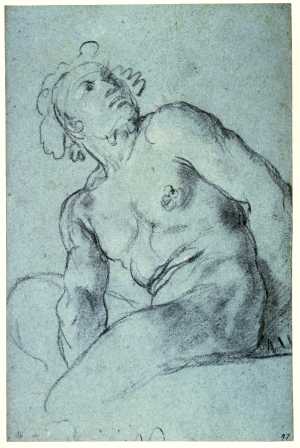Specifications
| Title | Study of a Seated Male Nude |
|---|---|
| Material and technique | Black chalk, heightened with white, on blue paper, laid down |
| Object type |
Drawing
> Two-dimensional object
> Art object
|
| Location | This object is in storage |
| Dimensions |
Width 221 mm Height 336 mm |
|---|---|
| Artists |
Draughtsman:
Annibale Carracci
|
| Accession number | I 183 (PK) |
| Credits | Loan Stichting Museum Boijmans Van Beuningen (former Koenigs collection), 1940 |
| Department | Drawings & Prints |
| Acquisition date | 1940 |
| Creation date | in circa 1595-1600 |
| Condition | Agenda 2016 |
| Inscriptions | '47' (below right, pen and brown ink, Crozat no., L.3612) |
| Collector | Collector / Franz Koenigs |
| Provenance | Francesco Angeloni (1587-1652), Rome; Pierre Mignard (1612-1695), Paris; Pierre Crozat (1665-1740, L.3612), Paris; his sale, Paris 10.04-13.05.1741, in lots 462-72 (to Mariette); Pierre-Jean Mariette (1694-1774, L.1852/2097 desunt but on his blue mount), Paris; his sale, Paris (Basan) 15.11.1775-30.01.1776, probably in lot 300 (F 168,19); - ; Emile Wauters (1846-1933, L.911), Paris; his sale, Amsterdam (Muller) 15-16.06.1926, lot 40 (Fl 800 to Cassirer for Koenigs); Franz W. Koenigs (1881-1941, L.1023a), Haarlem, acquired in 1926; D.G. van Beuningen (1877-1955), Rotterdam, acquired with the Koenigs Collection in 1940 and donated to Stichting Museum Boijmans Van Beuningen |
| Exhibitions | Amsterdam 1934, no. 518; Rotterdam/New York/Fort Worth/Cleveland 1990, no. 72; Sidney 1999; Florence 2000, no. 9; Rotterdam 2009 (coll 2 kw 1) |
| Internal exhibitions |
Italiaanse tekeningen in Nederlands bezit (1962) Van Pisanello tot Cézanne (1992) De Collectie Twee - wissel I, Prenten & Tekeningen (2009) |
| Research |
Show research Italian Drawings 1400-1600 |
| Literature | Amsterdam 1934, no. 518, ill.; Luijten/Meij 1990, no. 72, ill.; Agenda 2016, no. 36, ill.; Wittkower 1952, no. 303; Bologna 1956, no. 184, pl. 85; Paris 1961, p. 46, no. 77; Martin 1965, no. 124, fig. 238; Ginzburg 2008, p. 139 |
| Material | |
| Object | |
| Technique |
Highlight
> Painting technique
> Technique
> Material and technique
|
| Geographical origin | Italy > Southern Europe > Europe |
| Place of manufacture | Bologna > Italy > Southern Europe > Europe |
Do you have corrections or additional information about this work? Please, send us a message

























